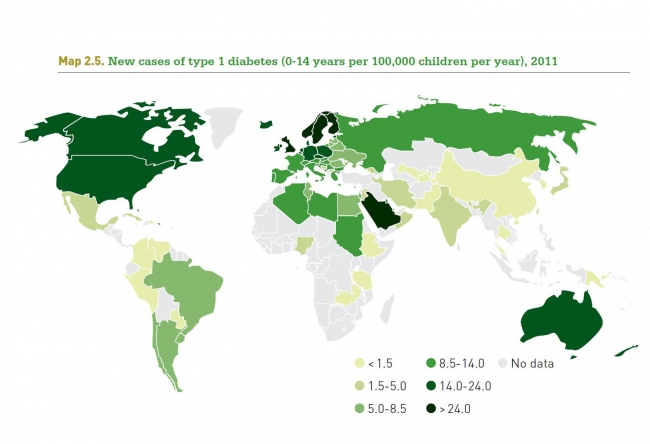Diabetes mellitus type 1 epidemiology and demographics
|
Diabetes mellitus type 1 Microchapters |
|
Differentiating Diabetes mellitus type 1 from other Diseases |
|
Diagnosis |
|
Treatment |
|
Cardiovascular Disease and Risk Management |
|
Case Studies |
|
Diabetes mellitus Main page |
|
Patient Information |
|---|
Editor-In-Chief: C. Michael Gibson, M.S., M.D. [1]Associate Editor(s)-in-Chief: Vishal Devarkonda, M.B.B.S[2]
Overview
Epidemiology and demographics of type 1 DM varies with geography, age, race and genetic susceptibility.
Epidemiology and Demographics
Prevalence
- Type 1 diabetes affects ~15-30 million people globally.[1]
- In 2012, Ada estimated the prevalence of type 1 DM in american children and adults at 1.25 million.[2]
- 5.6% of american adults diagnosed with diabetes mellitus have type 1 DM.[3]
Incidence
Incidence of type 1 DM varies with geography, age, race, and genetic susceptibility. Epidemiology and demographics of type 1 diabetes:[1][2][4][5][6][7][8][9][10][11]

b
| Factors affecting the incidence of type 1 DM | Relationship between factors and incidence of type 1 DM | Epidemiology |
|---|---|---|
| Geography | Incidence increases with increase in distance from equator | Incidence of type 1 DM per 100,000 persons a year
0.1 to 0.5 per 100,000 persons in Venezula and parts of China 37 to 65 in Finland and Sardinia 23.6 per 100,000 per year in non-Hispanic white children and adolescents 36 per 100,000 per year in Newfoundland, Canada |
| Age | Bimodal distribution, with one peak at four to six years of age and a second between 10 to 14 years of age. | |
| Gender | Gender doesn't affect the overall incidence of overall incidence of childhood type 1 DM | The prevalence and incidence oftype 1 DM doesn't vary with gender. |
| Genetic susceptibility | There is increased risk of developing type 1 DM in close relatives of a patient with type 1 DM | Lifetime risk of developing Type 1 DM
●No family history – 0.4 percent ●Offspring of an affected mother – 1 to 4 percent ●Offspring of an affected father – 3 to 8 percent ●Offspring with both parents affected – reported as high as 30 percent ●Non-twin sibling of affected patient – 3 to 6 percent ●Dizygotic twin – 8 percent ●Monozygotic twin – 30 percent within 10 years of diagnosis of the first twin, and 65 percent concordance by age 60 years |
| Race | Incidence of type 1 DM varies from race to race | Non-Hispanic white youth-2.55 ases per 1,000 children 0 to 19 years old
African American- 1.62 cases per 1,000 children 0 to 19 years old Hispanic-1.29 cases per 1,000 children 0 to 19 years old Asian-Pacific Islanders-0.6 cases per 1,000 children 0 to 19 years old American Indians-0.35 cases per 1,000 children 0 to 19 years old, respectively) |
References
- ↑ 1.0 1.1 "JDRF".
- ↑ 2.0 2.1 "ADA".
- ↑ Xu, Guifeng; Liu, Buyun; Sun, Yangbo; Du, Yang; Snetselaar, Linda G; Hu, Frank B; Bao, Wei (2018). "Prevalence of diagnosed type 1 and type 2 diabetes among US adults in 2016 and 2017: population based study". BMJ: k1497. doi:10.1136/bmj.k1497. ISSN 0959-8138.
- ↑ http://www.diapedia.org/type-1-diabetes-mellitus/2104085168/epidemiology-of-type-1-diabetes
- ↑ https://www.idf.org/sites/default/files/attachments/DV_56-SI2.pdf
- ↑ Silink M. Childhood diabetes: a global perspective. Horm Res 2002; 57 Suppl 1:1.
- ↑ Harjutsalo V, Sund R, Knip M, Groop PH. Incidence of type 1 diabetes in Finland. JAMA 2013; 310:427.
- ↑ Bell RA, Mayer-Davis EJ, Beyer JW, et al. Diabetes in non-Hispanic white youth: prevalence, incidence, and clinical characteristics: the SEARCH for Diabetes in Youth Study. Diabetes Care 2009; 32 Suppl 2:S102.
- ↑ Dabelea D, Mayer-Davis EJ, Saydah S, et al. Prevalence of type 1 and type 2 diabetes among children and adolescents from 2001 to 2009. JAMA 2014; 311:1778.
- ↑ Harjutsalo V, Sjöberg L, Tuomilehto J. Time trends in the incidence of type 1 diabetes in Finnish children: a cohort study. Lancet 2008; 371:1777.
- ↑ Tillil H, Köbberling J. Age-corrected empirical genetic risk estimates for first-degree relatives of IDDM patients. Diabetes 1987; 36:93.